What’s more important for B2B businesses: brand building or lead generation?
Naturally if you ask a PR agency, they’ll say brand building and if you ask a performance marketing agency, they’ll say the opposite. Some will say you need both, but what does that mean for your marketing plan’s time and budget? What does it look like in terms of ratios? 60:40? 80:20? 50:50?
The answer will depend on many factors: your audience, your market, your growth stage, and the nature of your product or service. If you were looking for exact percentages, I’m afraid you won’t find them here or anywhere else (unless that place is trying to sell you PR or lead generation).
Instead we’ll give you some food for thought on what your priorities might be. But first, some definitions…
TL:DR
- What is lead generation?
- What is brand building?
- Which one gets results?
- The 95-5 rule of B2B marketing
- Long term vs short term marketing
- Creating a balanced marketing plan
What is lead generation?
We don’t really need to define lead generation, since it’s pretty self explanatory. Lead generation gets you leads.
It’s the world of Google search ads, social media ads, banner ads on websites, landing pages, – anything that can push people over the line to make a purchase then and there – or at least give some contact details so you can follow up with email campaigns or direct sales outreach later.
It’s also worth talking about growth marketing here. This is a relatively new term that encompasses a data driven, experiment-based, performance model that essentially prioritises lead gen. It experiments to find the optimum spend for different marketing channels, so that new businesses can acquire as many customers as possible for as little cost as possible.
“Ultimately brand building should shift how people think and feel about and towards a brand for the better.”
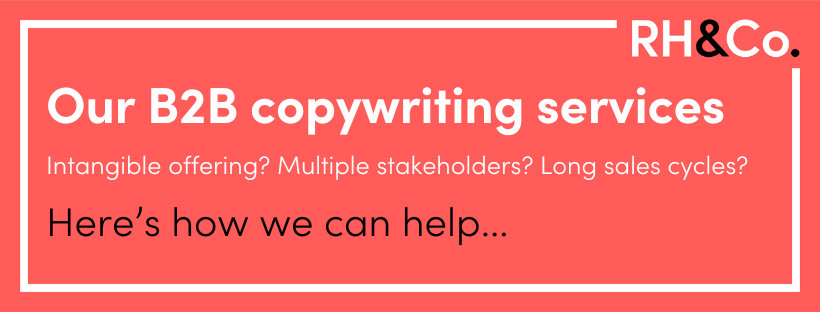
What is brand building?
Brand building is a bit more nuanced in terms of what it is and does.
Strictly speaking, anything that your business does to get noticed for the right reasons can be considered brand building. This makes it something that goes beyond the marketing department and into the remit of product design, customer service and even some aspects of HR.
Lead generation and brand building definitely overlap, especially when it comes to content. But there are tactics that lean more towards brand building than led gen, such as:
- CSR activities like sponsoring your local sports team or supporting a relevant charity
- Value-based content marketing such as producing helpful guides and other publications
- PR campaigns that widen your reach and boost your reputation with a certain market
Ultimately brand building should shift how people think and feel about and towards a brand for the better.
Which one gets results?
It’s pretty easy to measure how effective lead gen or growth marketing tactics are and prove their effectiveness.
You host a webinar and get 100 emails for your sales team to follow up on. You put money behind a LinkedIn campaign and get a dozen demo requests. These numbers can be tied fairly easily to the bottom line.
There’s a catch though – not all leads convert. Many companies throw loads of money at lead gen and see middling results. Either because they don’t get quality leads or they don’t have the content they need to nurture those leads once they get them. So it’s not as simple as more lead gen spend = more sales.
With brand building, attribution is far less obvious though. It’s unlikely that a football-loving Head of Procurement will see your brand’s logo on their team’s strip and immediately feel the urge to do business with you.
But what if your team sponsorship builds a positive feeling towards your brand in that Head of Procurement’s thoughts? And what if later they’re trying to choose between you and a close competitor? It may well be what pushes them over the line. You’ll never be 100% sure though.
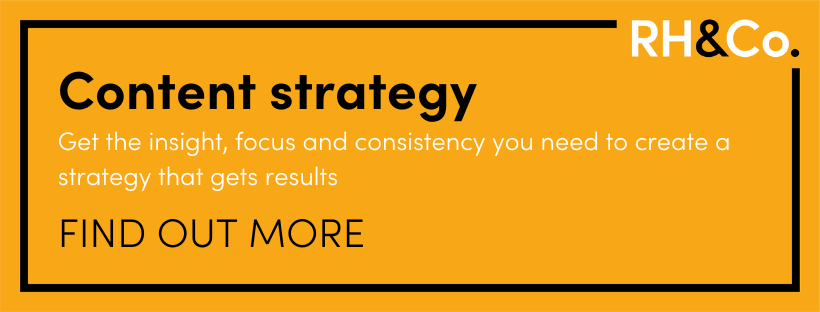
The 95-5 rule of B2B marketing
The problem with B2B marketing is that only 5% of your target audience is likely to be actively looking to buy at any given time. The other 95% may well be interested in the future but not yet. This is the 95-5 rule, which came out of a recent study by Professor John Dawes and the B2B Institute.
It’s not like selling haircuts or manicures, where a pay-per-click campaign can quickly redirect someone searching for ‘manicures in Bristol’ to make a booking at your new salon. B2B buying decisions often involve an audience that doesn’t understand what you do, a product that they won’t need for two years, or a service with such a high price tag that people will conduct serious research before they commit to any kind of decision.
That means it’s potentially more important for your B2B marketing activities to build a positive impression of your brand rather than just attempt to generate a lead then and there. That way you’ll be able to engage the 95% as well as the 5%. And done right, you won’t just create a positive impression, you’ll create trust.
FURTHER READING: Reinventing the buyer’s journey: introducing the RH&Co content marketing framework
Long term vs short term marketing
Brand building will introduce you to a wider audience so that when they’re searching for solutions in one-to-five years, you at least make the shortlist.
But sometimes, you can’t wait that long. You need your product launch in three months time to hit the ground running; you need cash flow to cover the costs of your new hires, or you need to get in front of your early adopters so you can begin to build brand momentum. Here lead generation is your friend.
Once you have that traction, brand building can help sustain it. For many B2B businesses, referral partners are an important source of leads. Brand building fuels the conversation with these key contacts, creating brand advocates from people and businesses that lie outside of your direct target audience.
Brand building can also increase customer lifetime value. You’re far more likely to renew your contract with your design agency if they’ve just won a prestigious award, for example. You’re also more likely to recommend them to others in your network.
At Rin Hamburgh & Co, the overwhelming majority of our business comes through referrals, recommendations and ongoing clients. If we turned off all our lead generation taps tomorrow, there might not be much difference. Intriguingly, that’s exactly what happened recently with Uber, Airbnb, P&G, eBay and a whole long list of household names who decided they were through with performance marketing.
Creating a balanced marketing plan
So, back to our original question – how do you decide where to allocate the most time and budget when creating your marketing plan?
Well, as Peter Drucker said, “Long-term results cannot be achieved by piling short-term results on short-term results.”
If your company is in its early growth stage, you probably need to prioritise short term results so you can get some momentum going, keep the bills paid, and sprint to the next funding round. Lead gen might do you wonders, and stop you from getting distracted by vanity metrics. Your blog can play a vital role in attracting and nurturing those leads too.
But if your organisation is struggling to qualify leads, catch the attention of bigger clients, or needs to stand out as an authority in your field, you’ll want to focus more on brand building.
For the best results, try to do both, dialling one or the other up a notch as the needs of the business evolve. Taking the long term view of a brand marketer and combining it with the results-focused mindset of a lead gen marketer plus growth marketing’s experimental approach is a powerful strategy that will take you far.
For more insights into how to split your marketing budget, check out the business benefits of blogging – and how to sell them to your boss.
As a marketing manager, you know that creating and maintaining a good, effective blog for a business isn’t easy. It takes time, thought, skill and budget. You also know that the business benefits of blogging absolutely outweigh the costs – but getting your boss on board is another matter.
Here’s a refresher to help you state your case – with metrics you can track to help demonstrate the return your blog will be able to generate for the business.
TL:DR
- Driving traffic to your website
- Improving your website’s SEO
- Creating a source of content for your social media channels
- Converting traffic to leads
- Supporting your sales team
- Establishing expertise
- Attracting talent
- One final business benefit of blogging
1) Driving traffic to your website
There are many places we can create and host content these days, from social media to publishing platforms like Medium. These all have their advantages but there’s a key problem – you’re not in control of those platforms. As Joe Pulizzi, founder of the Content Marketing Institute, says: “Don’t build your content on rented land.”
Because your blog sits on your website, you’re in control. It also makes it a great tool for attracting visitors. This can be done in different ways (e.g. via search, social media, or direct outreach) and is useful for a number of reasons, not least of which is that the more people you attract to your site, the more people you are likely to convert in some way.
What to track: Look at which page your website visitors land on first. If the percentage arriving through your blog increases, you know it’s doing its job attracting people to your site. You can also set up Google Search Console to show you which blogs are attracting the most visits from different keywords.

2) Improving your website’s SEO
Even if your primary means of attracting people to your blog is via social media, publishing blog content on your website will improve your site’s SEO in a number of ways:
- Showcasing expertise: Google is looking for EEAT – Expertise, Experience, Authority and Trustworthiness – and blogs are a greatway to showcase all four of these.
- Rich in key words: As you build up your blog content, you will naturally be building up the keywords that people use to find your website, especially long-tail keyword phrases, which have lower search volumes and competition but better conversion rates.
- More indexed pages: Simply by adding to your website regularly via your blog, you’ll be signalling to Google that your site is an active and relevant one.
- Increase dwell time: Great content will keep people reading. This increases their dwell time, something search engines look to as part of deciding how authoritative the site is.
- Opportunity for internal links: By linking your blogs internally (e.g. by creating a series), you can further increase the dwell time.
- Opportunity for backlinks: This is where other sites link to yours, increasing your Domain Authority (DA). Great content is more likely to attract backlinks than mediocre content.
- Counter AI overviews: With AI overviews reducing click throughs across the board, value-led blogs are going to be even more important for attracting readers through search.
What to track: There are lots of ways to judge how successful your content is for SEO, from where you rank for a given keyword to the volume of organic traffic you get.
3) Creating a source of content for your social media channels
A blog is foundational content, giving you something you can share and repurpose to engage with your audience across your social channels.
Think about this article, for example. It wouldn’t take all that much work to turn it into a series of social posts, each featuring one benefit, or a carousel with one on each slide.
You can draw out and share a single quote or statistic, use the premise of the blog to pose a question for your audience, or link it to a sales message. And you can mix up the formatting too, recording the key message in audio or video form.
What to track: To showcase how your blog supports your social strategy, you could track how much time you spend creating social content, as well as engagement levels.
“Blogging isn’t just about generating lots of attention at the top of the funnel – it’s also about helping to close the deal once your audience is further along their buyer journey.”
4) Converting traffic to leads
According to DemandMetric, companies that blog get an average of 67% more leads than those that don’t. Wherever a particular blog post is positioned in terms of the buyer journey, it can help your audience move one step along with an appropriate call to action.
If your audience is still unclear about their problem – what the RH&Co blogging framework calls ‘in the dark’ – you would start with softer CTAs encouraging them to read another post, sign up to a newsletter or follow you on social media.
Later, you might suggest that they download a piece of even more valuable content in return for their email address. And by the time you get to the ‘almost ready’ stage, you can step your CTA up and recommend that your reader books a demo, contacts your team or buys your product.
What to track: Think about which metrics are most important to you. This could include newsletter sign ups, lead magnet downloads, demos booked and so one.
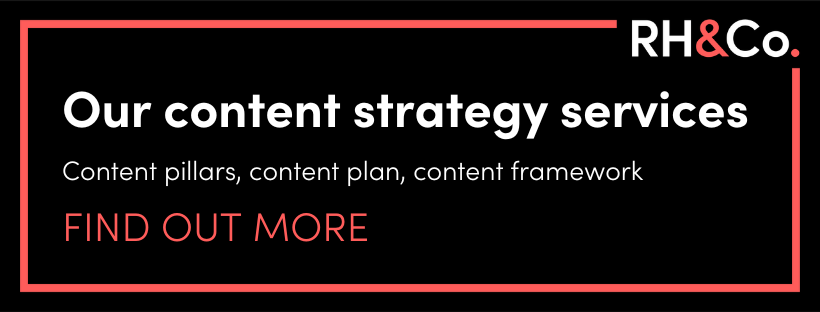
5) Supporting your sales team
Blogging isn’t just about generating lots of attention at the top of the funnel – it’s also about helping to close the deal once your audience is further along their buyer journey.
Bottom of funnel content includes objection busters and process posts. As an example, we have a post titled How can you blog for my business if you’re not an expert in my subject?. We know this has helped several marketing managers get buy-in from their boss or the team’s subject matter experts in order to bring us in to work with them.
Bottom of the funnel content can be shared on social media but it’s particularly effective when used proactively by your sales team to help convert leads into sales.
What to track: It’s rare that a blog post will close a deal in isolation so your best bet here is to get qualitative feedback from your sales team. They’ll be able to tell you whether they’re getting good results from the content they’re sharing.
6) Establishing expertise
The best way to convince someone of a business’s expertise is to demonstrate it. A blog is a platform on which to showcase the knowledge your subject matter experts have.
Blogs that help establish expertise include educational and problem-solving ‘how to’ posts – backed by real life examples and insights from subject matter experts that add weight to your writing – and opinion-filled thought leadership. Over time, creating this kind of original blog content will establish your brand’s expert reputation, building trust with your audience.
What to track: This is a much harder one as a) it’s just not that easy to quantify expertise and b) it’s a longer term strategy. Some indicators of your growing authority, however, could include press coverage, invitations for speaking engagements, and backlinks (which in turn are great for SEO).
7) Attracting talent
This one might not be on your radar but it’s a super powerful benefit, especially in competitive employment markets like tech.
If you’re on a recruitment drive, your blog can be a great tool for broadcasting your company culture and values – and how they play out in real terms. This not only makes you more attractive to the right people, but can weed out the wrong ones before you get started on the CV sifting.
What to track: This is another tricky one to get definitive numbers for but, if you link culture posts to CTAs directing the reader to a careers page or job advert, you can set click throughs as a target. That said, don’t dismiss the qualitative data – several of our clients have had candidates referencing the blogs we’ve created for them in interviews, so listen out for that.
One final business benefit of blogging
The great thing about blogging is that it has a cumulative effect. It won’t quickly go out of date like a social post, or need to have more money ploughed into it to keep it generating results like PPC.
Once you’ve pressed publish, it’s there for good. And as you publish your 10th blog, you will still be getting traffic from your first, with no additional effort.
Of course, generating this kind of value does rest on being committed to blogging as a long term strategy. You may get some results from publishing a handful of posts and then stopping but blogging isn’t a quick fix.
Online marketing guru Neil Patel says you need to give it at least 6 to 9 months, while Joe Pulizzi – who founded the Content Marketing Institute – writes in his book, Content Inc, that it’s more like 12 to 18 months.
So when you’re presenting your content strategy and looking for sign off on a budget for blogging, be sure to set the right expectations. But have confidence too. Blogging is a hugely powerful tool that will generate demonstrable results in time.
There comes a time as a business when you look back on your blog and realise that you’ve created an awful lot of content. Dozens, maybe even hundreds of posts. And you find yourself wondering whether you still need them all. Are they relevant? Do people read them? Have they become outdated? That’s when it’s time to do a blog audit.
A blog audit is a kind of spring clean that allows you to look at what you’ve got, assess it against set criteria, and – in a nutshell – figure out what’s working, what isn’t, and what you can do about it. Here’s how we go about it.
TL:DR
- Step 01: Define your blog audit goals
- Step 02: Work out what you’ve got
- Step 03: Time for an initial content prune
- Step 04: Work out which blog posts are not performing
- Step 05: Map your content against your customer journey
- Step 06: Identify and make plans for the gaps
- Step 07: Create a blog audit maintenance schedule
Step 01: Define your blog audit goals
Although there are overlaps between them, there are actually quite distinct reasons why you might be performing a blog audit.
For example, if you have a very SEO driven strategy then you may want to audit your content against keywords that are currently important to your business. This should, among other things, identify where you can update posts to help them perform better.
Sustainability is an increasingly important consideration for businesses and content adds a surprising chunk to your carbon footprint. For this reason, you might set a goal of reducing your content by a certain percentage. In this case, the goal of your audit is to identify the least useful posts so they can be culled.
What we’re focusing on in today’s blog, however, is the process we use with our expert-led clients. Their content strategy is usually centred on high quality content that builds authority and supports the customer journey. SEO tends to play more of a supporting role.
In this case, the content audit process is more about being able to:
- Ditch any posts that are definitely out of date
- Update any that are still generally relevant but could be improved
- Identify gaps for future content creation
You’ll want to include performance metrics to help you in your assessment. But in this post we’re going to be going beyond that and looking at some of the more subjective factors you need to consider in your decision-making process, especially when it comes to future opportunities.
Ultimately we’re aiming for a Keep, Cut or Change analysis that allows us to action our blog audit in the most effective way. We’ll also ideally want a Create list to help with future content creation.

Step 02: Work out what you’ve got
Hopefully you have an editorial calendar where you’ve been logging your blog posts as you go. This could be as simple as a spreadsheet of titles and publication dates. If not, you’ll need to start your blog audit by creating one.
This Hubspot guide goes into details about how to pull page data using a web crawler. But it doesn’t necessarily have to be that complex, especially since most of us aren’t dealing with that many posts. And even if you do automatically generate your starting point, you’ll want to add subjective insights of your own.
If you blog across a number of key categories, make sure you include these details in the log. For example, we write posts about Blogging, Websites, Copywriting, Marketing & Strategy, and Behind The Scenes.
You might have other labels you want to include in your list too. For example, the author of each post or the audience you’re aiming at, if you have distinct ones. For example, if you’re a recruitment agency, you might have client focused posts and candidate focused ones.
Adding these layers of information means you can begin to spot patterns and gaps. If you compare this sort of information to your performance metrics (e.g. visitor numbers, dwell time or conversion), you might notice that you get high traffic to certain blog types, or great engagement and conversions from others.
BUT don’t go overboard on detail here until you’ve had a look at the next step…
Step 03: Time for an initial content prune
The first thing to do once you’ve created your log is discard any blog posts that simply aren’t necessary anymore. Perhaps you no longer offer a particular service, so you don’t need any posts that are focused on that offering. Mark these as Cut.
These posts might still be performing well in terms of generating traffic. But if they’re drawing the wrong crowd, then you’re skewing your numbers and clouding the truth of how well your blog is performing. And content pruning can actually be great for your website’s overall SEO, so you won’t lose out.
Before you hit delete though, press pause. The content that you’re ditching may not be worthy of a space on your blog but are there any elements you can salvage? Much like an old dress that can be repurposed into a child’s T-shirt, your soon-to-be-discarded blog might have nuggets you can still use across social media.
This sifting process will take time, it’s true – but less time than it takes to create original content.
Step 04: Work out which blog posts are not performing
Posts that aren’t performing well can potentially also be added to the Cut list. For many businesses, blog performance will be about organic search traffic. This will require you to consult your analytics. Find out what’s driving the most visitors, what has the most backlinks and so on.
Social engagement metrics can be helpful here too. For example, thought leadership may not perform well for SEO but could generate a huge amount of engagement on LinkedIn. Pull this information from Google Analytics and add it to your log.
But remember that it’s not just about quantity, it’s also about quality, so consider what ‘performing well’ means to you. For example, a bottom of funnel post might not be generating loads of organic search traffic but your sales team might find it invaluable during their nurture, follow up or closing process.
Again, pause before you dismiss a post entirely. Just because it’s not performing well, doesn’t mean it’s terminal. Could you nurse the post back to health? More on this in the next step of your blog audit.
Step 05: Map your content against your customer journey
By now you should have a list of blog posts that are either still relevant and useful or could be with an update. The next step is to identify any gaps you might have. We’ve found that the best way to do this is to map each post against your customer journey.
A simple top / middle / bottom of funnel approach can be very useful here. But we like to add a layer of additional insight using the RH&Co content marketing framework, a tool we designed to use with our clients. It looks in more detail at key stages in the customer journey from your reader’s perspective, helping you to understand what type of content to produce and what the goal should be.
What you might find when you do this mapping exercise is that you have plenty of top of funnel content but you’re a bit sparse in the middle. Or you’ve got loads of educational middle of funnel content but nothing at the bottom to actually drive conversion or support your sales team.
It’s worth noting that you may need to create a buyer journey for each distinct product or service you offer. We call these strands of content ‘Buyer journey blog chains’.
As we mentioned above, there may also be some posts that fit well into your customer journey but need work before they can be considered truly valuable. It may be that your audience has shifted so you now want to be talking to HRDs rather than CEOs. Or legislation has changed, making certain references out of date but easily fixable. Mark these as Change.

Step 06: Identify and make plans for the gaps
This customer mapping process should highlight which of your current blog posts are serving a valuable purpose and can be labelled Keep. You should also be able to see which ones you need to Change in order to strengthen them or bring them up to date.
From here you’ll be able to see where your gaps are, giving you an excellent starting point for deciding what topics and titles you can schedule for the future. If there are lots of gaps, plug the most important ones first. This will differ depending on your business and priorities.
A good place to start the prioritisation process is to look back at what’s working and see whether this can be replicated in some way. Which posts drive the highest number of visitors? Which are the strongest when it comes to converting?
Remember that conversion will mean different things at different stages of the buyer journey – you’re unlikely to get a ‘book demo’ action from a top of funnel post but you might get a sign up for your newsletter.
You can even go as far as finding out what these high performing posts have in common, such as word count or post structure – perhaps your audience is really into long form content or numbered lists of tips. This will give you even more direction when it comes to creating new blog content.
Step 07: Create a blog audit maintenance schedule
As you can see, doing a blog audit isn’t a quick or an easy job. So use the experience to create a process you can follow in the future, noting what works and what doesn’t. Then make sure you come back to it from time to time – how often will usually depend on how frequently you’re posting – and do a little refresh.
By keeping on top of your maintenance schedule, you’ll ensure that your blog is always as valuable and effective as it can be. You’ll know what content you still need to create and you’ll be able to quickly see when anything needs updating.
You’ll also be able to rest easy knowing that the time, effort and budget you’ve dedicated to the blog is well invested and continuing to give you the return on investment you need.
If you’re stuck and need some support to get your back catalogue of blogs in order and create a plan for the future, get in touch to find out more about our content and blog auditing services.
There are many excellent reasons why businesses should add blogging to their marketing mix. But in the end, what you really want from any marketing channel is leads, right?
Now we’re going to caveat this post by saying something really important: content marketing is about the long game. If you try it out for a month and compare it to, say, paid advertising, that’s a bit of an unfair match.
However, just because blogging leans slightly more towards the brand building side of marketing than the pure growth marketing side, that doesn’t mean it can’t generate leads. If you’re strategic about it.
So here are five strategies to get your blog delivering more leads into your pipeline.
TL:DR
- Pick that low-hanging fruit
- Keep the not-ready-yet audience on your radar
- Create buyer journey blog chains
- Combine your blogging efforts with other channels
- Serve the robots, as well as the humans
- How to build lead generation into your blogging strategy
1. Pick that low-hanging fruit
There are a bunch of people out there who want to buy your products, use your services, donate to your cause or in some other way do the thing you want them to do. They just need help to get across the finish line.
Imagine, for example, that you’re the CMO of a rapidly scaling SaaS company. Your platform offers a way to shortcut a key process for your customer – but your competitor is saying the same thing.
That’s where a ‘How we…’ post comes in handy. By giving your audience a glimpse behind the curtain – showing them how your expertise works rather than simply telling them you have it – you earn a greater degree of trust. Trust that makes spending money with you that much easier.
And that’s just one example of a sales-led blog post. You could also write a post that breaks down your approach to pricing and showcases where the value lies for your audience compared to other options on the market. Or you could answer a key objection, like we have in ‘How can you blog for my business if you’re not an expert in my subject?’
Sales-driven blog content isn’t about the hard sell. It’s about facilitating great decision making. By the end of a great sales post, you can legitimately suggest that your reader gets in touch, books a demo or even taps ‘buy now’, because you’ve helped them see why that’s the right choice for them.
“Creating chains of interlinked blog content like this is a great way to guide your potential customer or client along the buyer journey until they become a lead. It also helps the reader to hop off the trail if they’re not a good fit for you.”

2. Keep the not-ready-yet audience on your radar
No matter what you’re offering and no matter who you’re offering it to, there’s no way that everyone in your target audience will be ready to buy at the exact moment they read your blog. This is particularly true in B2B marketing where studies show that 95% of your audience is out-of-market.
Your reader might not have the budget right now. Or they might have just bought something similar. Perhaps they need internal sign off, or they just want to think about it a bit more.
But if your blog has engaged them sufficiently, you can capitalise on your success by prompting them to do something.
You might ask them to follow you on social media, for example, or sign up for your newsletter so that you can continue to deliver useful content into their inbox. Or you could sweeten the deal with a lead magnet and create a nurture series to help move the process forward.
This might not be as immediately exciting to you as getting a reader to call your sales team, but by creating a way to stay in touch, you can continue to market to them until they are ready.
Whatever the case, don’t rely on the reader’s initiative. When they’re ready to buy, they probably won’t find their way back to your brand just because they read your blog a year ago. So create a tentative connection now that you can build on later.
3. Create buyer journey blog chains
Imagine your reader is at the very beginning of their buyer journey. They’re in the dark, not knowing they have a problem or, if they do, they’re only vaguely aware of the full extent of that problem or what’s causing it. You can change that. This is where you create content that helps them to explore the problem, validates what they’re feeling and shows them what the real issue is.
They won’t be ready to buy after reading. But they will be able to learn about the various solutions that can tackle their newly defined problem. After which they might be interested in exploring one solution in particular. And once they’ve reached that point, they might want to know the details of what you offer, including your process and pricing.
Creating chains of interlinked blog content like this is a great way to guide your potential customer or client along the buyer journey until they become a lead. It also helps the reader to hop off the trail if they’re not a good fit for you.
In a blog chain, you’ll adjust your CTA as your reader progresses. The earlier posts encourage further reading, lead magnet downloads or newsletter signups, and the later posts can get more sales-led.

4. Combine your blogging efforts with other channels
Good blog content is foundational. It shouldn’t sit on your website in isolation, with the vague hope that people will stumble across it. It needs to work with the other channels you’re investing in – and even feed those channels content.
The best way to get your blog generating leads is to ensure as many people as possible see it. And that means sitting it within a much wider strategy that includes, for example, social media, SEO, paid advertising, PR and so on.
If you’re using more than one marketing partner, make sure there’s enough communication between them. There’s no point having your PR or SEO agency going off in one direction and your blogging agency heading off in another.
Get your sales team involved too so that they make the most of the content you’re producing. It’s far nicer for a prospect to be sent a helpful blog post than to be hassled with a vague and ineffective, “Just wondering whether you need any help with X…”
5. Serve the robots, as well as the humans
If your sales machine relies on a high volume of input then one of the best and cheapest ways to generate the leads you need from your blog is to combine it with a well thought out organic search strategy.
This does not mean that you pick a few low cost, low competition keywords and stuff them willy nilly into a badly thought out post written by a barely literate stranger you found on Fivr. Not unless you’re happy to sacrifice your long term brand image for an initial flurry of visitors that offer nothing more than vanity metrics.
Google and co are likely to become increasingly human in their approach to judging the value of blog content over time, whereas people are unlikely to become more machine-like. So your flesh-and-blood audience still needs to be your first priority.
But there’s no reason why you can’t serve both robot and human. This is how we helped our client Addland generate 150,000 impressions and 7,000 clicks to their website within the first six months after they launched their land buying platform. It’s also why Blueheart’s internal content creator said our approach to SEO optimisation is so hidden that their posts “just feel like solid, well-researched, empathetically-written articles.”
How to build lead generation into your blogging strategy
As with any marketing channel, blogging needs to be a strategic activity with a clear plan that is outlined at the start and checked on regularly. That plan needs to be based on the needs of your audience, it needs to sit within a wider marketing strategy and it needs to have clear goals from the outset.
You’ll need to set your expectations properly too, giving the blog at least 9 months and more likely 12 or even 18 months to deliver regular and reliable leads, especially if you’ve got a long sales cycle.
Blogging isn’t a lead gen silver bullet. In fact we’d argue that there is no such thing. But with the right strategy and a great team to deliver the best quality content, blogging can absolutely generate leads effectively and consistently for any business.
Want to talk lead gen with the blogging experts at RH&Co? Get in touch today.
Every marketer has their favourite way of describing the stages of the buyer journey. Some stick with E St Elmo Lewis’s original AIDA model: Attention, Interest, Desire, Action. Others simplify it to Awareness, Consideration and Decision. Still others prefer an ‘awareness journey’: problem aware, solution aware, most aware and so on.
All are helpful to a degree, especially when planning your broader marketing strategy and channel mix. But if you try to apply them to generating topic ideas for your content marketing plan they’re not always so effective.
That’s why at RH&Co we’ve developed our own framework, based on the process we use to create editorial calendars for our clients. In this post, we’re looking at the five key stages your customer or client is likely to go through and the type of content you should be aiming to create at each one.
TL:DR
- Stage 01: In the dark
- Stage 02: Stuck
- Stage 03: Searching
- Stage 04: Almost ready
- Stage 05: Onboarding
- Bonus: reputation-building content for any stage
- How to use the RH&Co content framework
Stage 01: In the dark
In stage one, your reader is either not aware of their problem or not clear on their real problem.
For example, they might not realise that their app’s security is at risk because they haven’t got a maintenance schedule in place. Or they might know that they’re having stomach problems but not realise they have a wheat intolerance.
Goal
At this stage your goal needs to be to educate your audience and raise their awareness, identifying and exploring the problem until they’re really clear on what it is.
This audience type is right at the beginning of their journey, so this is not the time to rush them towards a sale. Instead, get them to the point where they feel confident about researching solutions.
Content
You could start with a piece of content about the wider issues facing your reader’s industry or share your opinion on why a particular problem is worth addressing.
You could also highlight the warning signs that might indicate a certain problem is looming or challenge them to think about an issue in a new way.

Stage 02: Stuck
Now your audience is clear that there’s a problem – but they have no idea what to do about it.
In the example above, your reader may be panicking about the security risk facing their new app or feeling relieved that their stomach pain has a genuine source. But how do you improve app security or deal with wheat intolerance?
Goal
The goal in this stage should be to add real value, introducing the variety of solutions that are available. It’s important not to focus too heavily on your own solution just yet – sell now and you’ll look self interested rather than genuinely helpful.
Your reader wants the facts laid out for them so that they can make an independent, informed decision about what’s right for them, without feeling pressured.
Content
This is where ‘how to’ content comes into its own. You can keep this content fairly broad, or start to narrow it down a little – although keep some ideas back for the next stage (you’ll see what we mean in a moment).
It’s also helpful to dig beneath the problems your reader is facing and help them understand why they’re having them. After all, it’s hard to fix something if you don’t know what’s causing it. And as humans, we’re naturally curious too.
Stage 03: Searching
Searching is like part two of Stuck. Now the reader is relatively clear on their problem and knows solutions exist. So the next step is for them to work out which of those solutions is best for them.
Is it getting a consultant in, training the in-house team or hiring a new specialist to ensure your app stays on top form? Does it mean cutting out wheat, taking a probiotic supplement or trying reiki?
Goal
This is where you start to explore each solution in depth, giving more facts such as advantages and disadvantages of each, and some idea of how to begin making the right choice.
Again, it’s really important to be honest rather than try to skew the reader towards your own offering. That only leads to unhappy clients and customers. If you’re a poor fit for each other, it’s best get them out of the funnel now so you can concentrate on the better fits.
Content
As we mentioned in the Stuck stage, you can use ‘how to’ content here as well. Only this time it will be more niche, focusing less on ‘how to reduce bloating’, for example, and more on ‘how to choose the right probiotic for wheat intolerance’.
You can also hone your angle to focus specifically on factors that will affect your reader’s choice, such as price, as well as comparing different options like for like.

Stage 04: Almost ready
By now your reader has not only settled on a solution but they’re considering your business – possibly alongside others – in order to make the very best choice.
The non-technical founder who didn’t realise that they had a security risk is now convinced that they do, and that they need a consultant – why should they choose you? Your wheat intolerant buyer is set on taking a probiotic every day but do they get your brand or a cheaper competitor option?
Goal
This is where you provide the granular details that allow your reader to make their decision to spend money with you – or at the very least to get in touch to talk to your sales team.
The emotion we want to stimulate now is certainty, and that is best done with facts rather than hype. Although the marketer’s missive is usually ‘benefits over features’, you need to dig into features here.
Content
Content for the ‘almost ready’ stage needs to contain plenty of detail – prices, processes and anything else your reader might want to know about you.
Here you can create objection busting content to support your sales team with the questions and challenges they face most often, and even try to put off anyone who is a poor fit by writing about why they shouldn’t buy your product or use your service.

Stage 05: Onboarding
So far we’ve used marketing within a marketing context and as a support for the sales process. Your reader has made a commitment to buy from you or use your services – but you’re not done yet.
Now we need to look at how content can support the onboarding process so that your customer or client is happy and more likely to stay or buy again.
Goal
The goal of onboarding content is to tackle ‘buyer’s remorse’, which can happen after you’ve made a purchase decision. That’s where your new customer or client thinks, “Was this really the right decision?” or “Did I get the best deal?” or even simply “Do I really need this?”
Instead, you want them to feel happy with their decision, not just about the product or service but you as a brand. You want them to feel as taken care of now they’re doing business with you as when you were courting them.
Content
Onboarding content will either make a new customer or client’s experience easier or enhance it in some way.
Going back to our original examples, the firm who has employed a consultancy to address their cyber security concerns might appreciate a guide to how to prepare for their first discovery session. The person looking to take probiotics as a way to support their gut health might also appreciate gut-friendly recipes or a four week meal plan.
Bonus: reputation-building content for any stage
Of course, there is some content that doesn’t quite fit neatly into any of these stages but is very much worth including because it can be enormously effective.
We call this reputation-building content and it can engage people wherever they are on their journey or even if they’re not in the market for what you’re selling at all.
Goal
As the name suggests, reputation-building content is all about establishing your brand’s reputation, for example as a thought leader, innovator or expert voice.
By doing this, you create a secure brand position that will pay dividends when people do begin their buyer journey, and you’ll also build connections within your industry and with the wider public.
Content
This is the most difficult type of content for your competitors to copy because it is based on your unique IP, experience or perspective as a business.
It can include opinions and angles on current topics, use case studies to demonstrate real life examples, and give glimpses behind the scenes into your culture, values and ways of working.
How to use the RH&Co content framework
In an ideal world, you would fill every stage of your content framework with well researched, highly valuable and engaging copy – preferably with a strand for each separate product or service you offer, or each industry vertical or client persona group you serve.
The reality is that you’ll need to start somewhere, so think about your main challenges and the quick wins you want to gain.
Perhaps your sales team needs a boost with bottom of funnel ‘almost ready’ content. Or maybe you’re working with an SEO strategist and want to catch people’s attention while they’re (quite literally) in the searching phase.
If you’re an expert-led business – in other words, your goal is to position your brand as an authority in a given subject area – then you need to start working on that reputation-building content.
We’ll be writing more about how to put our framework into practice in due course but in the meantime, if you’d like to talk about getting our support to create your content strategy, get in touch.
There are numerous occasions in business where persuasion is needed, the most obvious of which is in the marketing and sales process. Persuasive writing is therefore an essential skill for marketers and salespeople. But it can be a tricky thing to get right. And getting it wrong can be damaging to your brand.
Luckily, persuasive writing is something that can be learned – in fact, it’s something we offer training in. Here’s a starting point with techniques, tips and real life examples that showcase how it can be done to great effect.
First things first: what persuasive writing isn’t
We need to start by making one point really clear. Persuasion is not the same as manipulation or coercion. This isn’t about tricking people into believing something that isn’t true or forcing them to do something they don’t want to do.
In marketing and sales, your goal should always be to help your customer or client make the best decision for them. This article assumes that you’re a good fit for your audience – you just need to get their attention and help them to understand why so they can, ultimately, act on it.
If we’re all agreed on that, it’s time to look at how.
Persuasion is about people and psychology
Whether you’re trying to persuade a child to tidy up their room or a procurement lead to add you to a preferred supplier list, persuasion is all about psychology. Which is why it’s essential to start by learning about the people you’re trying to persuade.
What motivates them? What are they struggling with? What are their goals? What are their constraints? If you don’t get these basics right, you can craft the most articulate argument in the world and it’s going to fall on deaf ears.
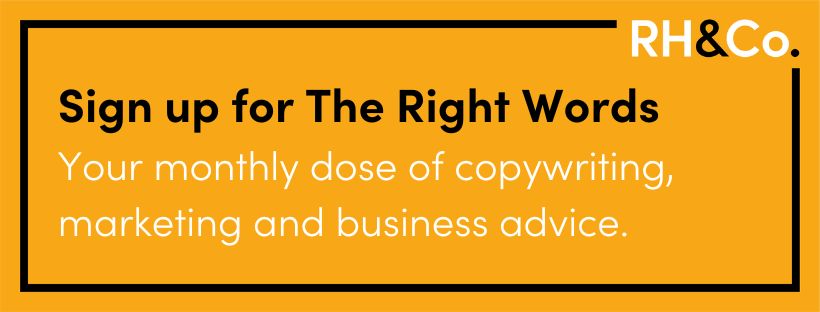
Offer a better version of the future
Once you know what your audience is struggling with or aiming for, you can begin to shape your persuasive argument to address this.
For example, let’s say you have a new HR tech product that makes the staff review process simpler and more efficient. Rather than jumping straight on the various impressive features your product has, paint a picture for your end user.
Help them to imagine what it would be like to spend less time doing face to face reviews. Or to have a happier and more effective team. Ultimately, you want to be able to answer the question “What’s in it for me?”
Persuasion is about stimulating the right emotion
Understanding what a better version of the future looks like for your customer or client is a really useful starting point. Now you have to communicate that message to your audience using words that will engage them, and one of the most effective ways of doing this is to use emotion.
In his book, Persuasive Copywriting, Andy Maslen talks about three main categories of emotion we can use to persuade people.
- Primary or universal emotions such as surprise, fear, happiness and sadness
- Secondary or social emotions such as pride, envy or curiosity
- Tertiary or background emotions such as excitement, calm and tension
Have a look at any given website, advert, flyer or other piece of copy designed to persuade, and you should be able to work out what emotion the copywriter was trying to illicit when they wrote the copy.
Here are a few examples of using emotion as a persuasive technique in website copy we’ve written for our clients:
Petals at Bibendum | pride
This copy we wrote for Petals at Bibendum is designed to appeal to high end customers who have the budget and desire to spend several hundred pounds on flowers without thinking too much about it. The words create a sense that there is an exclusive club and subtly asks whether they belong to that club. In doing so, it appeals to the sense of pride that this audience group would no doubt have about their good taste.
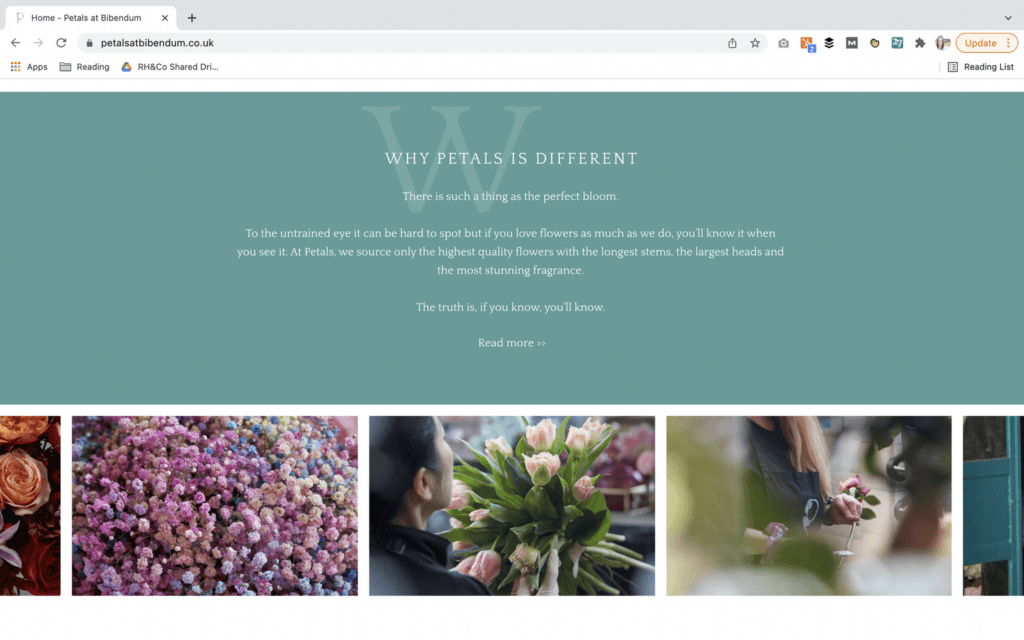
AppLaunch | calm
Developing an app might feel like a stressful, complicated process. The team at AppLaunch wanted to reassure their clients that it didn’t have to be that way. This section of copy encapsulates the simplicity of the process and is designed to create a feeling of calm in the reader, causing them to breathe a sigh of relief.
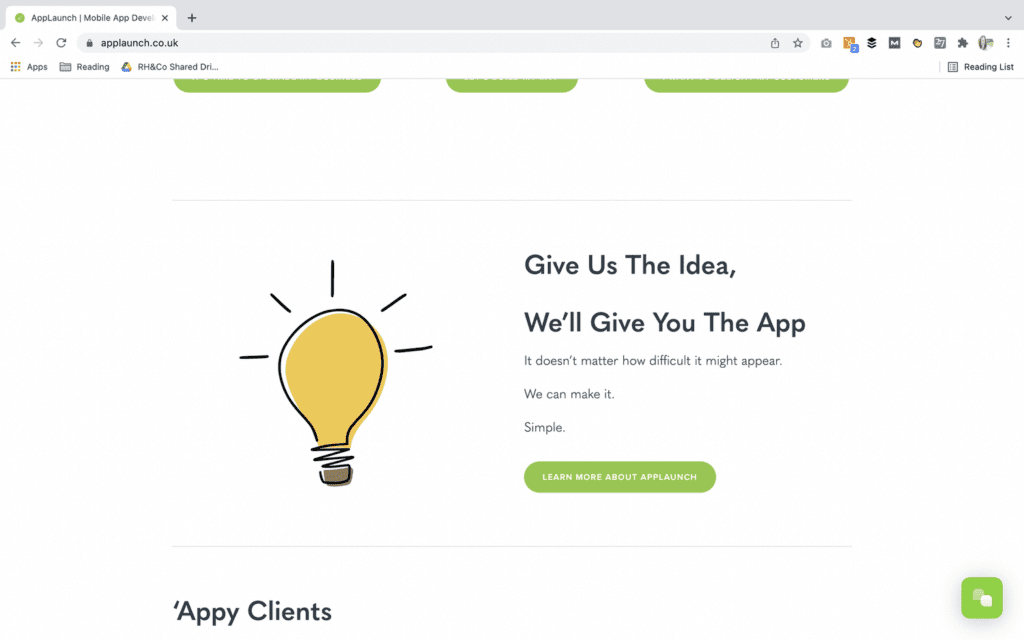
Stylemongers of Bristol | curiosity
Curiosity has got a bad reputation thanks to clickbait headlines that try to hack it in a manipulative way. But appealing to curiosity can be both authentic and very effective, as shown on this sales page we wrote for Stylemongers of Bristol.
Rather than jumping straight into an explanation of what the box contains and why it’s so valuable, the words we use stimulate the reader to use their imagination. Only then do we go into what’s actually in the kit.
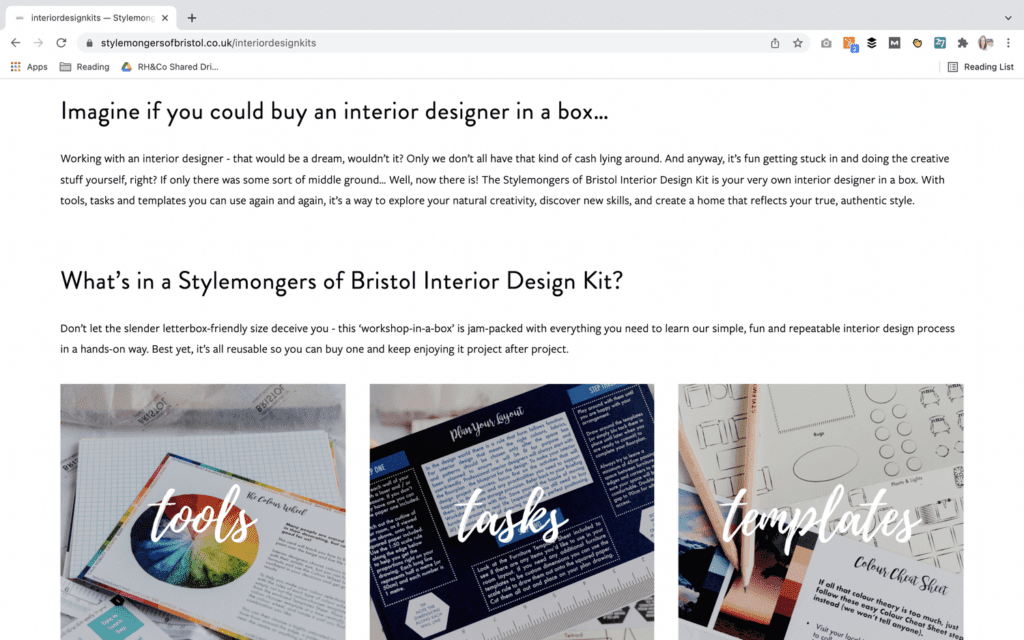
Show, don’t tell
If we’d just described the Stylemongers of Bristol kit as a ‘designer in a box’ without adding more detail, the reader would have been left thinking, “Yes, but what actually is it?”
People make decisions with hearts and minds, so once you’ve used emotion to get their attention, make sure you offer something more substantial too.
And be sure you can prove it. Showing is a far more effective way of persuading someone than telling.
So don’t tell me you’re ‘passionate’ about using local produce at your restaurant – show me what percentage of your ingredients are sourced within a 20 mile radius. Don’t tell me your team building exercises improves staff morale – show me a customer testimonial to prove it or a reputable study that backs your techniques.
Other persuasive writing techniques
We’ve already talked about how emotion is a powerful persuasive technique. Here are a few others to try.
Storytelling
Human beings have always loved stories and they can be used in a number of ways in a persuasive context. For example, case studies are a great way of using client success stories to help persuade your audience by providing social proof. And charities often use stories to persuade people to donate by showcasing real life people who have benefitted from their work.
Your brand story might also be important. You’d think that people would choose a soft drink based on how it tastes, for example. But we know that for Lovely Drinks, their homemade, Somerset roots are integral to their brand and why people choose them, which is why we highlighted this in their website copy.
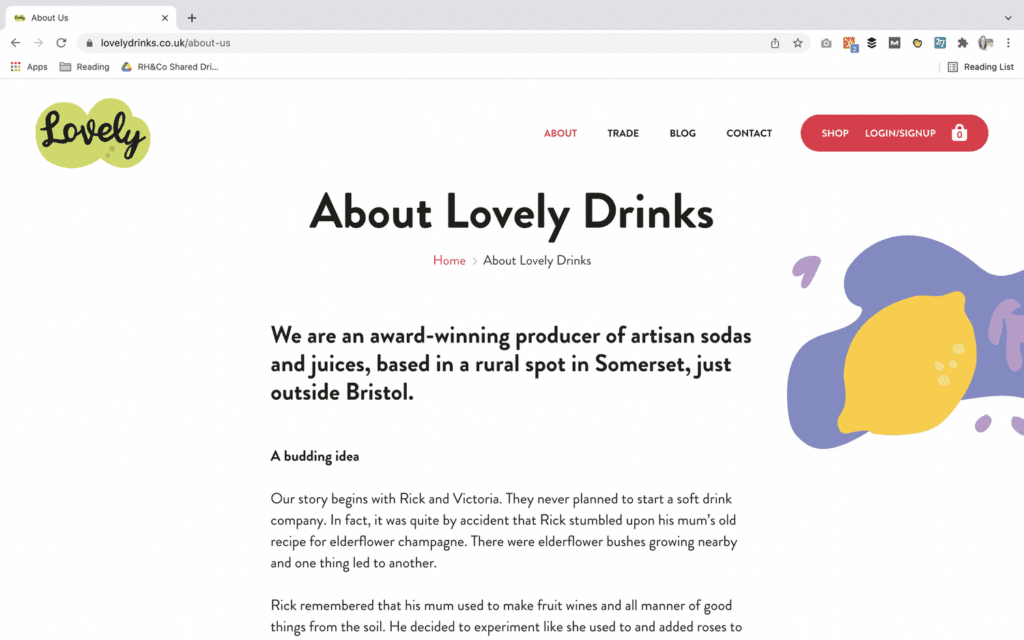
The power of three
There’s something about trios that just work, so long as you don’t overuse them. Whether it’s three words or three sentences, now you know that this is a persuasive writing technique, you’ll start noticing it everywhere. It’s popular in speech writing in particular. And remember ‘Hands, Face, Space’?
We used the power of three on the PlanIt Future website below to build emotion. The first sentence lays out a challenge creating tension. The second builds on it, escalating the tension. Then the third comes in and provides a solution, creating a sense of relief.
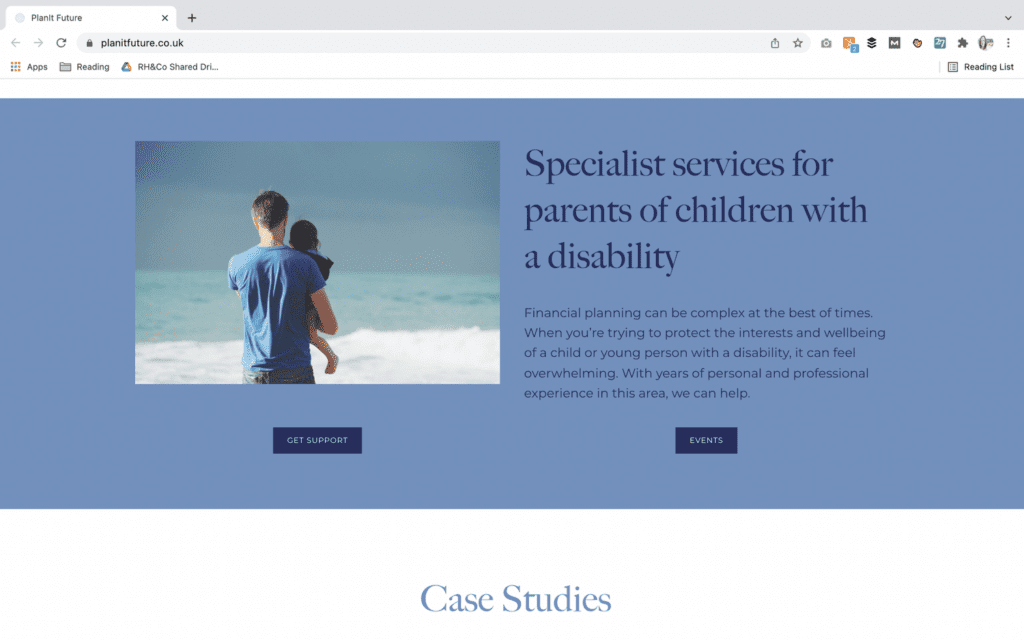
Personalised pronouns
Using personalised pronouns like ‘we’ and ‘you’ establishes a more personalised relationship with your audience. And relationship is essential for persuasion, as we’ll come onto in a moment.
We played on this persuasive technique when we wrote the Engineered Arts website. The line “Humans, check this out” as well as the personalised pronouns further enhanced the sense of conversation between brand and reader.
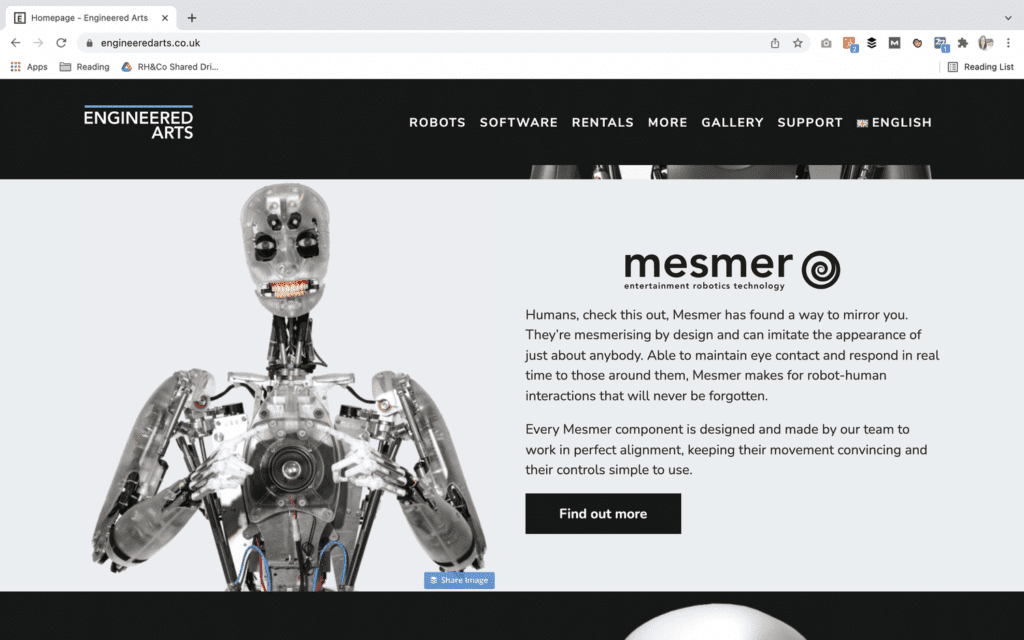
Imagine how different this paragraph would have felt if we’d written, “Engineered Arts has found a way to create robots that mimic people.”
Imperative sentences
An imperative sentence doesn’t have a subject. Instead it begins with a verb. Imperative sentences are also known as command sentences, and they are ideal for persuading people to act. This is why calls to action (CTAs) are usually imperative sentences.
Here’s a good example from Garrett Creative where we used a double CTA, both using imperative sentences, to create options for visitors at different stages of their customer journey.
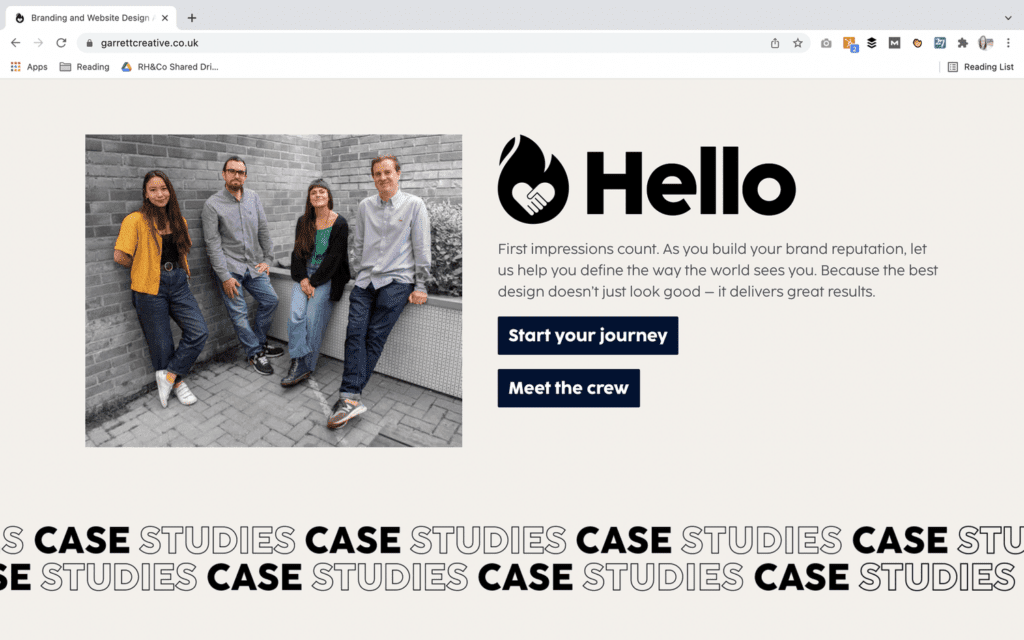
Building relationships – the importance of timing
Last but not least, persuasion isn’t just about what words you use. It’s also about when you use them. Because if you go in too hard, too early, you’re going to come across like a pushy car salesman.
The most effective persuasion comes from a foundation of relationship. We’re not enormous fans of Gary V’s ‘Jab, jab, jab, right hook’ analogy as we’d rather not paint marketing and sales as a violent sport! But the principle is sound. It’s all about adding value for your audience and earning your right to ask for what you want.
You also need to know where your customer is on their journey. If they’re only just figuring out that they have a problem, don’t jump straight in and try to shove your solution down their throat.
Help them explore the problem and understand it fully, perhaps with a blog post, video or webinar. Showcase the broad types of solution available and the advantages and disadvantages of each. Maybe now they’re ready to give you their email in return for a useful download.
The more complex, important or expensive a buy decision is, the longer it’s likely to take. Which means you might need to adjust your perception of persuasion as a ‘get them over the line’ approach.
Persuasive writing can have an instant effect, of course – we’ve all bought something on a whim because we were hooked by a clever advert from a brand we’ve never heard of. The important thing is to understand where that’s possible and plan for the times when it isn’t.
If you know your audience and what they’re looking for, if you speak to both their heart and their head, and if you let them come to you in their time, you’ll have far more success than if you resort to being pushy.
Around 60% of businesses never make it to their fifth birthday. As we reach this important milestone, Rin looks back on some of the important factors she believes have helped us to beat the odds.
This month RH&Co turns five. I say this month because I can’t remember the exact day. I can’t remember an awful lot from that period in my life, to be honest. I was single-parenting 9-month-old twins at the time, so I spent most days in a fog of feeding and changing and bashing out the odd email or blog post in between.
If you’d have walked down my street around then, you may well have seen me in the front passenger seat of my car, tapping away at my laptop while the babies slept in the back. Or I might have been asleep too, my head lolling against the window. Goodness knows what my neighbours must have thought.
Things have come a long way since then. We’re now a team of six with two more starting in September and job ads out for two more. We have clients around the world, we’ve won awards, attended events at Number 10 Downing Street and the House of Lords…
If you’d predicted any of those things when we got started, I would have laughed in your face. I know you’re supposed to start a business with a strategy and a vision and a plan of some sort, but honestly I started mine with little more than bullheaded determination to make it work.
Luckily, I’ve learned a lot along the way….
TL:DR
- Surround yourself with people who understand
- Actively pursue knowledge
- Understand what your zone of genius is
- Trust the marketing process
- Don’t be afraid to fire a client
- Never stop dreaming
Surround yourself with people who understand
About a month or two before I launched RH&Co, I was invited to a networking group called Freelance Mum where you could (and still can) bring your kids along. Bored of baby groups full of mums on mat leave talking about the benefits of baby led weaning and whether or not to try sleep training, I gave it a go.
Being surrounded by other mums juggling kids and running a business was both encouraging and inspiring. These women got it! They loved their children but they had other passions to follow too. They made me feel normal and they became my cheerleaders as well. I’m still friends with them today.
My business has changed since then though. So now I have a monthly Zoom catch up with a small group of female founders who all have teams of between 5 and 15 people and who are dealing with many of the same issues as I am. Again, our meetings inspire and encourage me, helping me to see that it’s not just me.
Running a business can be so lonely at times. It really does pay to have people around who understand.
Actively pursue knowledge
One of the best things that happened to me as a new business owner was hearing about what was then called Entrepreneurial Spark and is now the Natwest Accelerator. I started on the programme when the agency was just six months old and was thrown headfirst into one of the steepest learning curves of my life.
I learned from my mentor (thank you, Andy!). I learned from other business owners on the programme. I learned from the many experts they brought in to talk us through the first steps (and next steps) in everything from recruitment and finance to growth mindset and resilience.
I’ve continued to learn since, devouring books, podcasts and webinars, attending conferences and simply talking to other people. I genuinely believe that everyone has something to teach me – even if it’s what not to do.
I think a lot of founders feel a pressure to know everything, but to me there’s nothing as important as being teachable and prioritising your own development.
“Don’t try to be all things to all people. Understand what you do best and keep getting better at it. ”
Understand what your zone of genius is
This is something that works at both an individual and a business level. Just as we need to remember that we don’t always know everything, it’s also important to admit where your weaknesses lie.
I am not an especially organised person. I’m more about creative ideas and enthusiasm than Gantt charts and forecasts. While we should always be developing ourselves, there are times when we need to stay within our ‘zone of genius’ and let others operate in theirs.
Learning to delegate has been one of the most important lessons I’ve learned in business and I’m so pleased to have incredibly talented people in my team who are far better at their role than I would be.
The business equivalent of this philosophy of staying in your zone of genius is strong positioning – check out the amazing work of David C Baker for everything you need to know on that subject.
As a copywriting agency, we could write anything for anyone. But we don’t. We don’t write advertising copy or press releases or leaflets or tenders. Instead, we help expert-led businesses to clarify and communicate their message and establish their expertise through content.
Don’t try to be all things to all people. Understand what you do best and keep getting better at it.
Trust the marketing process
There is so much content out there promising a quick fix for generating leads. But the truth is that there is no rushing business development.
We ramped up our content marketing efforts around the middle of 2019, increasing our blog frequency (from fortnightly to weekly), social media presence (from posting ad hoc to three times a week) and newsletter output (from monthly to fortnightly).
For six months, although engagement was good, we didn’t see much in the way of that translating into leads.
As 2020 started, however, things began to shift. And with the exception of the first couple of months of lockdown, our revenue has increased steadily month on month ever since. In the last financial year turnover was up 55% on the year before, and we’re on track to significantly better that this year.
Overnight successes are rare. Create a solid marketing strategy and then give it time to work. Tweak your tactics, by all means, but don’t chuck the baby out with the bathwater just because you don’t see overnight results.
Don’t be afraid to fire a client
When we were first starting out, I was so grateful to anyone who wanted to use our services that I didn’t stop to think too hard about whether I enjoyed working with them. As a result, I was involved with a fair few projects that caused way more stress than they were worth.
In a creative services business like ours, bad clients usually fall into one of three categories.
There are those who simply don’t value you and who expect you to jump when they say so. There are those who say all the right things but then disregard your advice and insist on doing things their own way.
And then there are the really sweet and lovely clients who are nevertheless so needy that they end up taking far more time than you’d budgeted for – something the authors of Content Fortress refer to as the ‘damsel in distress’ client.
While we’re making an effort to not include any of these in our client base, it is the first group that is an absolute no-no for me. If a client treats anyone in my team with anything other than the respect they deserve, I won’t hesitate to walk away, no matter how much they contribute to my bottom line.
Running a business is hard. Surely one upside should be getting to choose who you work with?
Never stop dreaming
When I started this business, I didn’t have a vision or a mission. Five years later, I have finally articulated both.
VISION To help individuals and organisations achieve their dreams using the power of words.
MISSION To build a market-leading agency that demonstrates the highest business practices, delivers tangible results for our clients, and is a great place to work.
It’s not all that complicated when you look at it like that. But one thing the last five years have taught me is that just because something isn’t complicated, doesn’t make it easy to achieve. These are big dreams.
Luckily, I still have that same bullheaded determination to make it work. And I think maybe that’s another thing to add to the list of things you need in order to succeed in business. A belief in yourself that you can do it.
And you know what? I think you can.
App developers, financial modellers, commercial mathematicians – all examples of clients we’ve worked with. And yet we’re not experts in any of these subjects. So how do we do it? The answer is as much about the nature of blogging as it is about our own skills and experience.
TL:DR
- It all started in a newspaper office
- Why experts don’t usually make great marketers
- The added extras that a copywriter will bring to your blog
- How we create expert-led content for our clients
- A case study: Actual Experience, experts in human experience
It all started in a newspaper office
Our founder, Rin, started her career as a journalist. Cutting her teeth on a daily paper meant having to very quickly get up to speed about all sorts of subjects, doing research and interviewing experts in order to put together a compelling story – all to a tight deadline.
This journalistic approach underpins the way that we write content here at RH&Co. We don’t profess to be experts on embedded banking or leadership development or clinical psychotherapy. But we are experts at drawing out a story. Give us a few hours and access to an expert and we can get ourselves up to speed enough to write a convincing blog post on literally anything.
But that’s only part of the story. Because whether or not someone can blog about a subject they’re not an expert in might not actually be the most important question. Perhaps it’s more important to think, “How can I blog for my business if I’m not an expert at blogging?”

Why experts don’t usually make great marketers
The problem with being an expert is that you’re usually too close to your own subject. You know so much that it’s hard to tease out what your audience might be interested in and what is unnecessary detail that’s just going to distract them from what’s important.
A lot of experts try to cram too much into one blog post, not thinking of content in a holistic way. They don’t think strategically about what details might suit someone who is just thinking about a service versus someone who is getting ready to buy.
Experts often use overly complex language and too much jargon. They don’t always have the right understanding of tone and personality when it comes to writing, falling back on formal or even academic writing.
And on top of all of that, experts are usually very, very busy. Which means blogging falls down the to do list and becomes inconsistent at best. And that, as any marketer will tell you, is not going to deliver real results.
“A good copywriter knows how to get people’s attention in just a few words while also hitting SEO targets.”
The added extras that a copywriter will bring to your blog
As well as helping you to tease out the details of your expertise that will add the most value to a specific blog post, a copywriter will add a bunch of other important marketing elements.
Let’s start with the title, since that’s where – as David Ogilvy once said – you spend “80 cents of your dollar”. If your title isn’t 100% engaging, no one is going to read any further. A good copywriter knows how to get people’s attention in just a few words while also hitting SEO targets.
Then there’s structure. A copywriter knows to use page formatting tools such as subheads, bullet points, pull quotes and more to stop the ‘off-putting wall of text’ phenomenon that so many expert blogs suffer with.
They’ll also be able to craft a call to action that suits the post. Whether that’s a gentle and directional ‘read more posts in this area’ on a top-of-funnel post, or a firmer and clearer ‘get in touch for a quote’ on a sales-driven post.
And that’s all without even mentioning the content strategy that should come well before any briefing or writing even starts. If you’re going to work with a copywriter to create expert-led content, it’s essential that the work is guided by a clear strategy.

How we create expert-led content for our clients
Our blogging projects all start with a discovery stage where we get to know our new client. Who they are, what they do, what makes them special. The core messages they’re hoping to communicate and the goals they have for their content.
We talk about their audience too, of course, looking for the value that our client might be able to add at every stage of the customer or client journey. From this we can create a strategy with a rough editorial calendar that will direct future briefings.
From here, we set out a monthly briefing schedule. In these meetings we interview their experts, drawing out the stories in the data, the emotional connection in the list of facts, stripping out any needless jargon to leave only what supports the core messaging.
Ultimately our job is to take a client’s expertise and make it more succinct, punchy and powerful than it would otherwise be. We don’t need to be experts because that’s your job. Our job is to draw out your expertise and then package it up using precisely the right words to establish that expertise within the minds of your audience.
A case study: Actual Experience, experts in human experience
Actual Experience is a B2B tech business providing human experience management for service providers and their enterprise clients. Their unique analytics capabilities pinpoint the causes of variability and poor experience within the digital ecosystem, enabling digital leaders to prioritise investment in an evidence-based way.
Yes, we were baffled by that at first too. But as we worked with their founder, their marketing manager and their technical lead, we began to build up a solid picture of their expertise.
Marketing Manager Vaq Hussain said: “We’re in a complex and technical industry. With no prior experience of our expertise, Rin and her team quickly took on board what we do and how it helps our customers add value.”
Over the course of the project, we created a number of white papers, supplemented with blog posts and social sharing copy – all of which met the client’s high standards in terms of both expertise and readability.
“The process of developing a white paper with Rin and her team was simple and painless,” Vaq said. “They delivered a really fast turnaround following interviews and research, and the final copy required minimal amends.
“I would say Rin Hamburgh & Co’s strengths are not just in their writing. Rin and her team are excellent listeners. Finding the important details in what we were telling them, understanding the relevance to our audience and converting it to a usable content piece is what impressed me the most.”
Like buying a car or changing offices, commissioning new website copy isn’t something you do every day. It’s more of an every few years sort of thing. Which is why most people – whether business owners or marketing managers – don’t feel completely confident with the process.
We, on the other hand, write website copy on a pretty much weekly basis. We’ve worked with clients from sole traders to multinational businesses and private sector organisations on both brand new sites and sites that are evolving. So we have a really clear idea of what needs to happen and when, in order to make the process as pain free as possible.
Whether you’re a first timer or you’ve been down this road several times before, this guide will tell you everything you need to know about what we do and how we do it.
TL:DR
- Before it all starts – taking a bespoke approach
- The briefing session – getting to know you and your audience
- The copywriting bit – where the magic happens
- Added extras – FAQs, case studies and hidden copy
- When should you get a copywriter get involved in a website project?
Before it all starts – taking a bespoke approach
Clients come to us in all sorts of positions so it doesn’t make sense to treat them all the same.
- Some are creating a website from scratch, others are evolving or overhauling a site that already exists.
- Some know exactly what they want to communicate, others need a hand articulating their value proposition.
- Some have a wireframes already designed, others want to get their copy sorted first before design work starts.
We take all of this into consideration when creating a proposal for a website copywriting project and build in the support that the individual client needs.
For example, if you need support with clarifying your message we can offer this as an initial piece of consultancy work. We’ll deliver the messaging copy first – get feedback and do amends – before building that into full website copy.
Likewise, you might need guidance around structuring the copy on the page, if you haven’t got a wireframe. In that case we might work on the outline first and ask you to approve it before we start on the copy itself.
“If social proof is important to your audience, make sure you’re leveraging the good work you do with case studies.”
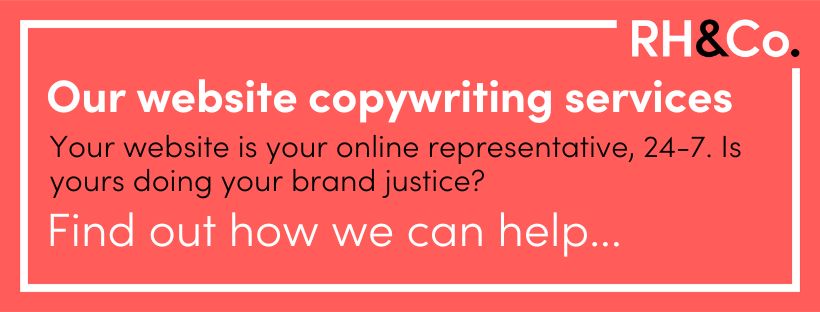
The briefing session – getting to know you and your audience
Your website briefing session will be tailored to your individual circumstance and can usually be booked in within a week or two of confirming that you’d like to work with us. A standard briefing is around one hour but it might be more, especially if you need support with messaging.
If you’re creating a brand new website, we’ll need to know everything from what your product or service is about to who your audience is to what your overall goals are for the site. We’ll need to understand your brand personality and tone too, so that we can write in a way that reflects who you are as a business.
On the other hand, if you’re evolving your website copy we’ll need to discuss what’s not working with the old copy and how much the factual content of the site needs updating. We’ll still need to ask about your audience, your goals and so on, because the more we understand about your business, the more likely the copy is to deliver results.
Before we even get to the briefing though, we’ll ask you to send across any supporting documents, from tone of voice guidelines to audience personas to client testimonials, so we have everything we need to get started.
The copywriting bit – where the magic happens
If you need support with messaging, we’ll begin our work here, sketching out messaging pillars and key phrases for your approval before any website copywriting begins. Next – and this will happen even if you don’t need messaging support – we’ll do a couple of test pages, to get your feedback on language, tone and structure.
This iterative approach means that when we do deliver the first draft of the whole site, you’re likely to have far fewer amends.
How long the copywriting stage takes depends, of course, on how big the site is. Whatever the case, we’ll have created a timeline at the beginning of the project, detailing not only what we’ll do and when, but the the timings you need to hit in order to keep things on track.
We’ll deliver your draft copy via Google Docs, giving you and your team a live document in which to make comments. Once we’ve had all your feedback through, we’ll work on your amends. If there are any more changes needed after the second draft, we’ll keep going until it’s right – though it’s rare anyone needs more than two amends stages at the outside.
At this point your website designer or developer will upload the copy to the site – and you might find it needs a few tweaks. We’re very happy to do that, and to give the whole lot a final proofread to make sure no errors have crept in during the design process.

Added extras – FAQs, case studies and hidden copy
As well as your standard set of website pages, you might want to add extras such as an FAQs page, case studies or even ‘hidden’ copy like meta descriptions and the 404 Error pages.
FAQs: These are super useful for your audience and great for SEO too, as you can use lots of keywords in the H2 subheadings in a very natural way. Linking FAQs answers through to blog posts will keep readers on your site longer and reduce your bounce rate too.
Case studies: If social proof is important to your audience, make sure you’re leveraging the good work you do with case studies. We can create simple case studies based on a briefing with you, or go one step further to interview your customers or clients and create really compelling and valuable case study content.
Hidden copy: From cementing your brand voice and personality on a 404 Error page to driving better SEO results through clever meta titles and descriptions, hidden copy might be a useful addition to your website project.
When should you get a copywriter get involved in a website project?
If you haven’t yet kicked off your website project and you’re thinking you’ll give it a while before you get a copywriter involved, you might want to reconsider.
Words are fundamental to the success of your website. They need to be able to tick the right boxes for Google and engage even the most time-poor skim readers with clever headlines, answer key queries quickly and drive action through effective CTAs.
A good copywriter or agency will be able to support you with all of this and more, so the earlier you get them involved the better.
Do you have any other questions about our website copywriting services? Get in touch with one of the team for a chat.
Search Engine Optimisation. We all know it’s important. But for many of us, it remains something we have only a vague grasp of at best. If that’s you, then read on. Because this blog post requires no technical ability whatsoever. It does, however, contain some very practical ways you can improve your dwell time.
TL:DR
- What is dwell time?
- Break down that wall of text
- Make it visually appealing
- Use internal (and external) links
- Using dwell time as a benchmark
What is dwell time?
Simply put, it is the amount of time that a user spends on your website from the moment they click through from a search page to the moment they click back to the search results.
Dwell time is often talked about in parallel with bounce rate. If a visitor arrives on your website and clicks away from it without visiting another page, that’s considered a bounce. Ideally, you want to increase your dwell time and reduce your bounce rate.
Of course, this is a very simplistic view. After all, if you’re looking for a company’s phone number then you’re likely to land on their contact page, get the number and very quickly leave without going anywhere else. That’s not a bad result, it’s a logical one.
However, let’s assume we’re talking about a blog post. In this case, we don’t want people staying on the page for just a few seconds because this shows that the article wasn’t very helpful. This is where increasing dwell time is important. So how do you do it?

1) Break down that wall of text
There’s nothing more off-putting than a screen full of text with no variation. It feels impenetrable, like it’s going to take a lot of effort to get the information you want. This can easily cause a significant percentage of your visitors to click away without bothering.
What you want to do is to give them entry points into the page that will draw their attention and get them to read more. Subheads are great for this, setting out your main points and giving an easy-to-access overview of what the reader can look forward to if they commit to reading the body copy.
Another advantage of subheads is that, because they are highlighted with H2 tags, they are weighted more highly for SEO and are therefore a great place to insert keywords.
Other ways to visually break up your text include bullet points, and pull quotes – like the one below. A pull quote should be taken from a little later in the post and is used to ‘tease’ the reader with what’s coming up.
“In every blog post you write, make sure you include at least one link to another part of your website.”
2) Make it visually appealing
As well as subheads, consider using imagery to break up your text even further and add an element of visual appeal. The nicer something is to look at, the longer your visitor is likely to stick around.
The type of imagery you use will depend on your brand and your audience, of course. For example, if you’re a travel agent then it’s nice and easy – simply weave in a handful of aspirational destination shots through your blog and you’re sorted.
For a B2B services brand, you might wonder how you can use imagery but there are actually plenty of options. For example, you could include graphs or tables to illustrate key points. Or look at the way we create ‘further reading’ panels using our brand imagery, colours and fonts below.

3) Use internal (and external) links
In every blog post you write, make sure you include at least one link to another part of your website. After all, the more pages your visitor reads, the longer they’re on your site. Plus it will help get your bounce rate down.
Linking to another blog post relevant to the subject you’re writing about is always a good option, as it’s pure value add. But you can also link to a product or services page, or your About page, or anything else you feel your reader would genuinely be interested in.
Our visual ‘read more’ panel below is a good example, but add links in the main body of text too. Make sure the phrase that you add the link to contains words that match with the destination content. For example, we wouldn’t want to ask you to click on ‘this link’ because that doesn’t mean anything, but we might suggest you check out our Small Business Resources.
And don’t forget about external links too. It might seem counterintuitive to send people away from your site but consider Google’s main goal: to connect people to the most useful information possible. If we link this post from Moz on the ‘5 SEO recommendations that matter’ – which you’re likely to find useful, since you’re reading this blog – then that signals more value adding and will encourage Google to rank us more highly.
TOP TIP: When linking to an external site, make sure you set the link as ‘open in a new tab’ so that your reader doesn’t get distracted.
Using dwell time as a benchmark
Dwell time is only one factor that contributes to a good SEO strategy. But it’s important because it acts as a good indicator of how valuable and engaging your content is. It’s a tangible metric that you can measure against.
In this post we’ve mainly focused on blogs but the same sorts of things would apply if you were talking about a product or services page, for example. Don’t have too much text all in one block. Make sure the page is visually appealing. And create links where it’s appropriate.
Have a look at what the dwell time on your website is now and then implement some of the suggestions above. Keep an eye on your numbers and see what effect the changes are having. Experiment, test, measure and keep tweaking so that you squeeze every last drop of value out of your content.
And if you’ve got a copywriter or copywriting agency involved in writing content for you, then make sure you’re reporting back or giving them access to your stats so that they can help move the dial in the right direction.
